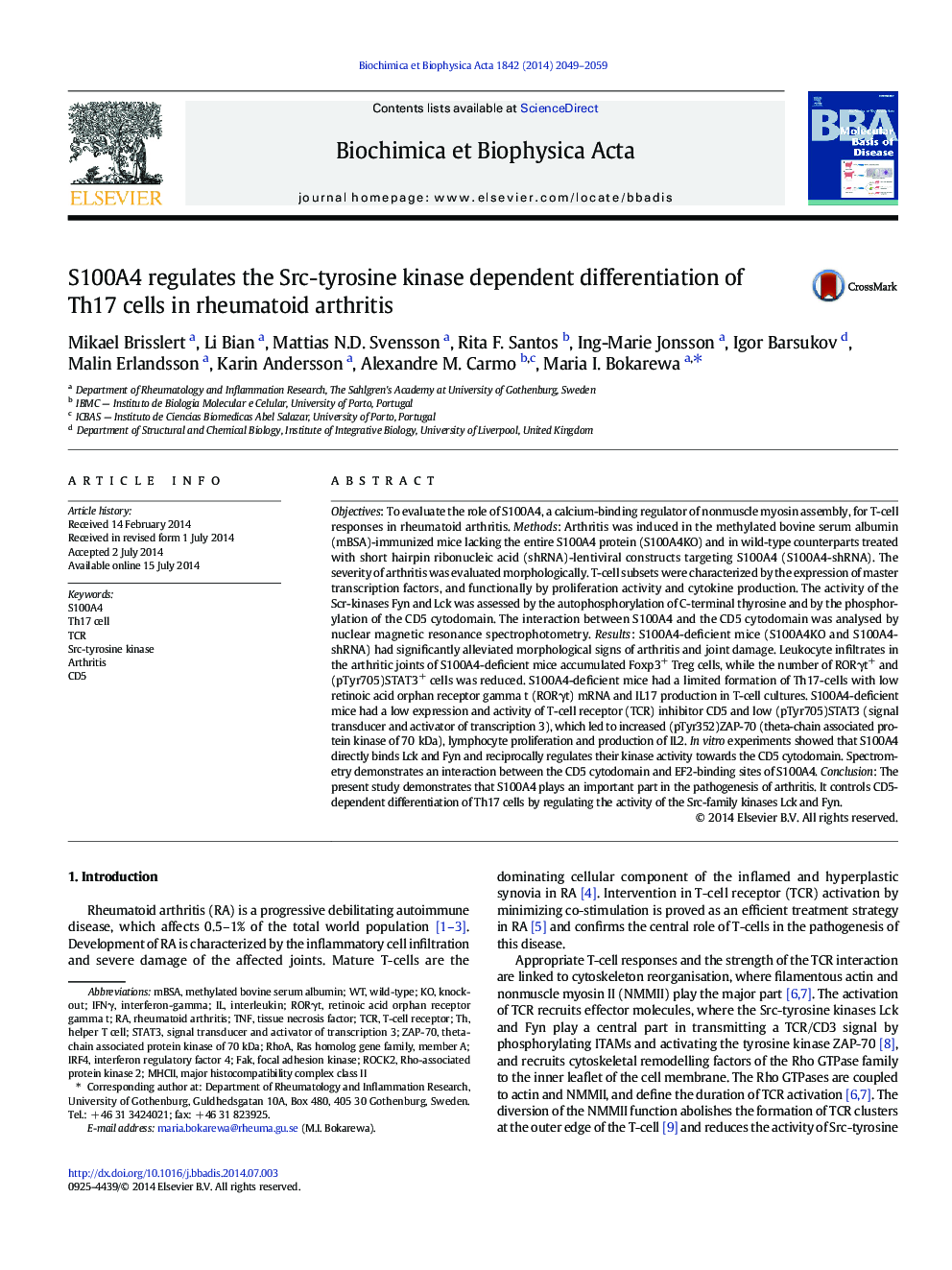| کد مقاله | کد نشریه | سال انتشار | مقاله انگلیسی | نسخه تمام متن |
|---|---|---|---|---|
| 1904714 | 1534654 | 2014 | 11 صفحه PDF | دانلود رایگان |

• S100A4 binds Scr-kinase Fyn and Lck regulating their kinase activity.
• S100A4 deficit affects Fyn-reliant function of CD5 releasing T cell proliferation.
• S100A4 deficiency limits Fyn–STAT3–IRF4 dependent formation of RORγt+ Th17 cells.
• Limited formation of Th17 cells alleviates arthritis in S100A4 deficient mice.
Objectives: To evaluate the role of S100A4, a calcium-binding regulator of nonmuscle myosin assembly, for T-cell responses in rheumatoid arthritis. Methods: Arthritis was induced in the methylated bovine serum albumin (mBSA)-immunized mice lacking the entire S100A4 protein (S100A4KO) and in wild-type counterparts treated with short hairpin ribonucleic acid (shRNA)-lentiviral constructs targeting S100A4 (S100A4-shRNA). The severity of arthritis was evaluated morphologically. T-cell subsets were characterized by the expression of master transcription factors, and functionally by proliferation activity and cytokine production. The activity of the Scr-kinases Fyn and Lck was assessed by the autophosphorylation of C-terminal thyrosine and by the phosphorylation of the CD5 cytodomain. The interaction between S100A4 and the CD5 cytodomain was analysed by nuclear magnetic resonance spectrophotometry. Results: S100A4-deficient mice (S100A4KO and S100A4-shRNA) had significantly alleviated morphological signs of arthritis and joint damage. Leukocyte infiltrates in the arthritic joints of S100A4-deficient mice accumulated Foxp3+ Treg cells, while the number of RORγt+ and (pTyr705)STAT3+ cells was reduced. S100A4-deficient mice had a limited formation of Th17-cells with low retinoic acid orphan receptor gamma t (RORγt) mRNA and IL17 production in T-cell cultures. S100A4-deficient mice had a low expression and activity of T-cell receptor (TCR) inhibitor CD5 and low (pTyr705)STAT3 (signal transducer and activator of transcription 3), which led to increased (pTyr352)ZAP-70 (theta-chain associated protein kinase of 70 kDa), lymphocyte proliferation and production of IL2. In vitro experiments showed that S100A4 directly binds Lck and Fyn and reciprocally regulates their kinase activity towards the CD5 cytodomain. Spectrometry demonstrates an interaction between the CD5 cytodomain and EF2-binding sites of S100A4. Conclusion: The present study demonstrates that S100A4 plays an important part in the pathogenesis of arthritis. It controls CD5-dependent differentiation of Th17 cells by regulating the activity of the Src-family kinases Lck and Fyn.
S100A4 coordinates a balance between proliferation and differentiation of antigen-exposed T-cells promoting CD5–Fyn–RhoA–STAT3 dependent effects.Scr-tyrosine kinases Lck and Fyn control T-cell receptor (TCR) signalling by the phosphorylation of an immunoreceptor tyrosine-based activation motif of the CD3 chains and of the TCR-inhibitor CD5. S100A4 binding to Lck and Fyn reciprocally regulates their kinase activity and gains control over T-cell proliferation. It limits the Lck-dependent phosphorylation of ZAP-70 (theta-chain associated protein kinase of 70 kDa) and facilitates Fyn-dependent phosphorylation of CD5. S100A4 promotes a link between the Fyn and RhoA (Ras homolog gene family, member A)-system, which coordinates phosphorylation of IRF4 (interferon regulatory factor 4) and STAT3 (signal transducer and activator of transcription 3), the transcription factors critical for the expression of RORγt (retinoic acid orphan receptor gamma t) and the formation of Th (T helper) 17 cells.Figure optionsDownload high-quality image (170 K)Download as PowerPoint slide
Journal: Biochimica et Biophysica Acta (BBA) - Molecular Basis of Disease - Volume 1842, Issue 11, November 2014, Pages 2049–2059